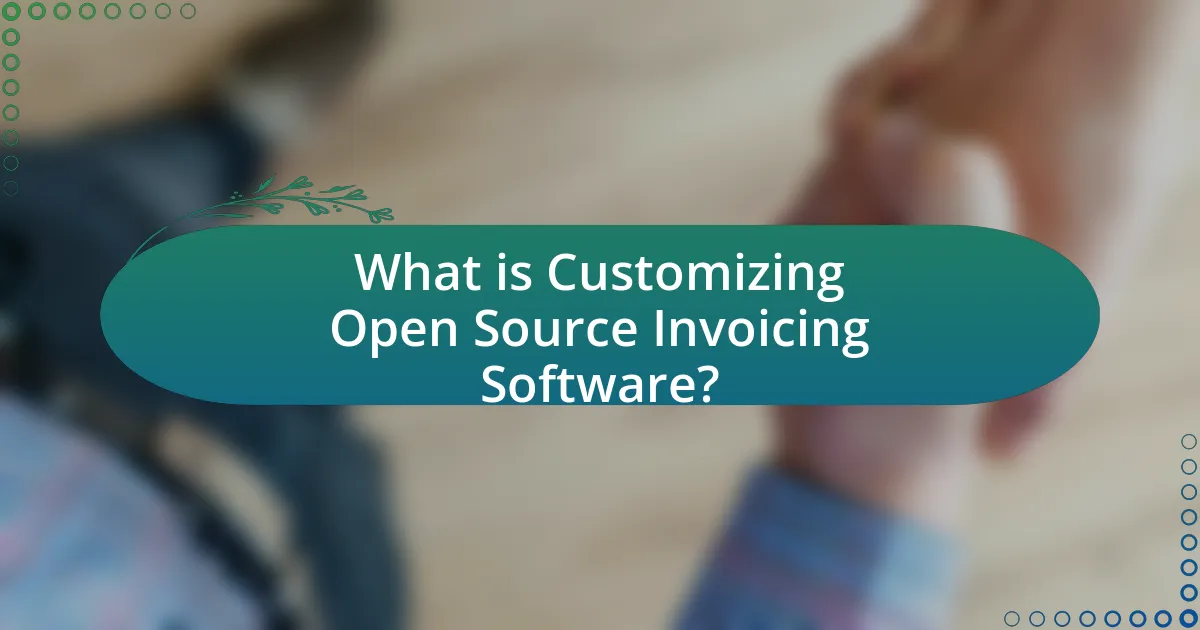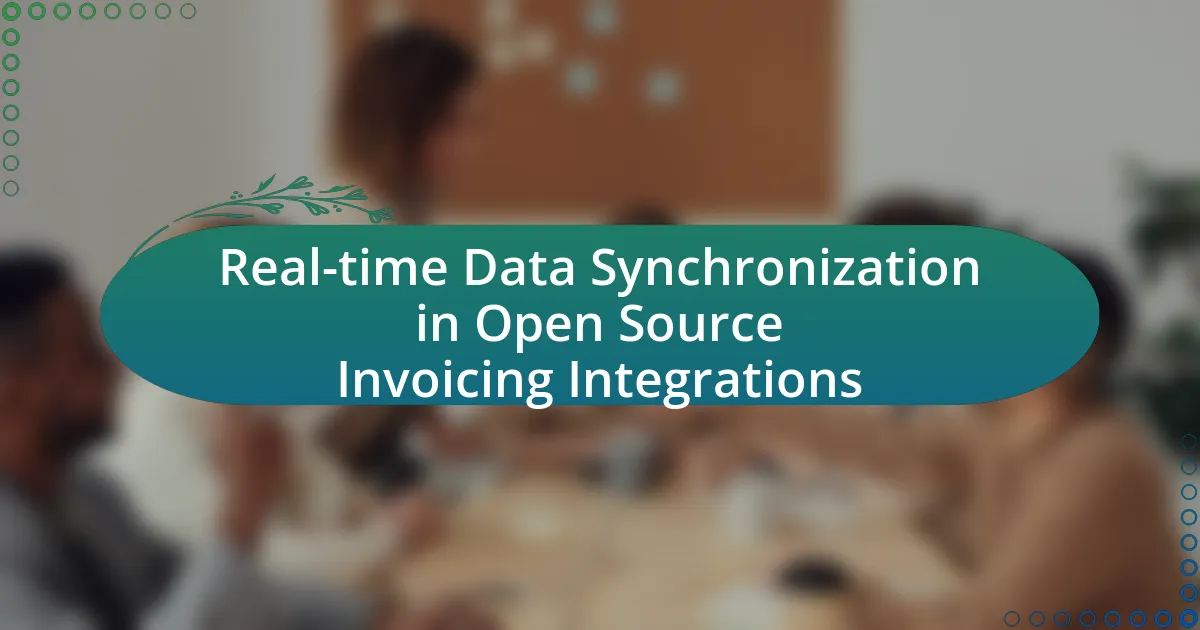Customizing open source invoicing software involves modifying its code and features to align with specific business needs, enhancing functionalities such as invoice templates, payment processing, and reporting tools. This article explores the benefits of customization for developers, including improved user experience and integration capabilities with other systems. Key features that can be tailored include modular architecture, customizable templates, and API integration. Additionally, the article addresses challenges developers may face during customization, best practices for integration, and the importance of community support in the development process. It also highlights security considerations and resources available for developers seeking to optimize their invoicing software solutions.

What is Customizing Open Source Invoicing Software?
Customizing open source invoicing software involves modifying the software’s code and features to meet specific business needs or preferences. This process allows developers to tailor functionalities such as invoice templates, payment processing, and reporting tools, ensuring that the software aligns with unique operational requirements. Open source software provides access to the source code, enabling developers to implement changes and enhancements that are not possible with proprietary solutions. This adaptability is supported by a community of contributors who often share best practices and plugins, further enriching the customization potential.
How does customizing open source invoicing software benefit developers?
Customizing open source invoicing software benefits developers by allowing them to tailor the software to meet specific business needs and enhance functionality. This customization leads to improved user experience, as developers can modify features, interfaces, and workflows to align with user requirements. Additionally, developers can integrate the software with other systems, such as accounting or CRM tools, which streamlines processes and increases efficiency. The flexibility of open source software also enables developers to innovate and implement new features quickly, fostering a competitive edge in the market.
What are the key features of open source invoicing software that can be customized?
Key features of open source invoicing software that can be customized include modular architecture, customizable templates, API integration, user role management, and multi-currency support. Modular architecture allows developers to add or remove functionalities as needed, enhancing flexibility. Customizable templates enable users to modify invoice layouts and branding to align with their business identity. API integration facilitates seamless connectivity with other software systems, such as accounting or CRM tools, improving workflow efficiency. User role management provides the ability to define access levels for different users, ensuring data security and appropriate permissions. Multi-currency support allows businesses to invoice clients in various currencies, catering to a global customer base. These features collectively enhance the adaptability and functionality of open source invoicing software for diverse business needs.
How does customization enhance user experience in invoicing software?
Customization enhances user experience in invoicing software by allowing users to tailor the interface and functionality to meet their specific needs. This personalization leads to increased efficiency, as users can streamline their workflows by accessing the features they use most frequently. For instance, a study by the Nielsen Norman Group found that customized interfaces can reduce task completion time by up to 30%, demonstrating the tangible benefits of user-centric design. Additionally, customization fosters a sense of ownership and satisfaction, as users feel more in control of their invoicing processes, ultimately leading to improved engagement and productivity.
Why choose open source invoicing software over proprietary solutions?
Open source invoicing software is preferred over proprietary solutions primarily due to its flexibility and cost-effectiveness. Open source software allows users to modify the source code to meet specific business needs, enabling tailored functionalities that proprietary solutions often lack. According to a 2021 survey by the Open Source Initiative, 78% of businesses reported that open source software provided better customization options compared to proprietary alternatives. Additionally, open source solutions typically have no licensing fees, which can significantly reduce overall costs for businesses, especially startups and small enterprises. This combination of adaptability and affordability makes open source invoicing software a compelling choice for organizations looking to optimize their invoicing processes.
What are the cost implications of using open source invoicing software?
Using open source invoicing software can significantly reduce initial costs, as there are no licensing fees associated with its use. However, organizations may incur expenses related to customization, maintenance, and support, which can vary based on the complexity of the software and the level of expertise required. For instance, a study by the Open Source Initiative indicates that while the software itself is free, businesses often spend 20-30% of their total software budget on implementation and ongoing support. Thus, while open source solutions can lower upfront costs, total cost of ownership may be comparable to proprietary software when factoring in these additional expenses.
How does community support impact the development of open source invoicing software?
Community support significantly enhances the development of open source invoicing software by providing collaborative contributions, feedback, and resources. This collective effort leads to faster bug fixes, feature enhancements, and overall software improvement, as evidenced by projects like Invoice Ninja, which thrive on community input for continuous updates and user-driven features. Furthermore, community engagement fosters a diverse pool of developers who share knowledge and best practices, resulting in more robust and innovative solutions. The presence of active forums and repositories, such as GitHub, demonstrates how community-driven discussions and contributions directly influence the software’s evolution and adaptability to user needs.

What integration techniques are available for developers?
Developers have several integration techniques available, including API integration, webhooks, and middleware solutions. API integration allows developers to connect different software applications by using predefined interfaces, enabling seamless data exchange. Webhooks provide a way for applications to send real-time data to other applications when specific events occur, enhancing responsiveness. Middleware solutions act as intermediaries that facilitate communication and data management between disparate systems, ensuring compatibility and efficiency. These techniques are widely used in software development to enhance functionality and improve user experience in applications like open source invoicing software.
How can developers integrate third-party services with open source invoicing software?
Developers can integrate third-party services with open source invoicing software by utilizing APIs provided by both the invoicing software and the third-party services. This integration typically involves identifying the relevant API endpoints, authenticating requests, and implementing data exchange protocols such as REST or SOAP. For instance, many open source invoicing solutions like Invoice Ninja or Dolibarr offer extensive API documentation that guides developers on how to connect external payment gateways, CRM systems, or accounting software. By following these guidelines, developers can ensure seamless data flow and enhance the functionality of the invoicing software, ultimately improving user experience and operational efficiency.
What APIs are commonly used for integration in invoicing software?
Commonly used APIs for integration in invoicing software include Stripe, PayPal, QuickBooks, and Xero. These APIs facilitate payment processing, accounting, and financial management. For instance, Stripe provides a robust payment gateway that supports various payment methods, while PayPal offers a widely recognized platform for online transactions. QuickBooks and Xero APIs enable seamless synchronization of financial data, enhancing the invoicing process by automating bookkeeping tasks. The integration of these APIs is essential for developers looking to customize open-source invoicing software effectively.
How do webhooks facilitate real-time data exchange in invoicing systems?
Webhooks facilitate real-time data exchange in invoicing systems by enabling immediate notifications of events, such as invoice creation or payment updates. When a specific event occurs in the invoicing system, a webhook sends an HTTP POST request to a predefined URL, allowing external applications to receive data instantly. This mechanism eliminates the need for constant polling, which can be resource-intensive and slow, thereby enhancing efficiency. For example, when a payment is processed, the invoicing system can trigger a webhook that sends the payment details to an accounting software, ensuring that both systems are synchronized in real-time. This immediate data transfer supports timely decision-making and improves overall workflow in financial operations.
What are the best practices for customizing and integrating invoicing software?
The best practices for customizing and integrating invoicing software include understanding user requirements, utilizing APIs for seamless integration, and ensuring data security. First, developers should gather detailed user requirements to tailor the software effectively, as this aligns the software’s functionality with user needs. Second, leveraging APIs allows for smooth integration with other systems, enhancing workflow efficiency; for instance, integrating with accounting software can automate data transfer and reduce manual entry errors. Lastly, implementing robust security measures, such as encryption and access controls, protects sensitive financial data, which is critical given that invoicing software handles personal and financial information. These practices collectively enhance the usability and reliability of invoicing software.
How can version control systems aid in the customization process?
Version control systems aid in the customization process by enabling developers to track changes, collaborate efficiently, and manage different versions of the software. These systems allow multiple developers to work on the same codebase simultaneously without conflicts, as they can merge changes seamlessly. For instance, Git, a widely used version control system, provides branching features that let developers create isolated environments for testing customizations before integrating them into the main project. This minimizes the risk of introducing bugs into the production environment. Furthermore, version control systems maintain a history of changes, which facilitates easy rollback to previous versions if a customization does not perform as expected, ensuring stability and reliability in the software development process.
What testing strategies should developers employ after customization?
Developers should employ unit testing, integration testing, and user acceptance testing after customization. Unit testing ensures that individual components function correctly, while integration testing verifies that these components work together seamlessly. User acceptance testing involves end-users to confirm that the customized software meets their requirements and expectations. These strategies are essential as they help identify bugs and ensure the software operates as intended, ultimately leading to higher user satisfaction and reduced post-deployment issues.

What challenges do developers face when customizing open source invoicing software?
Developers face several challenges when customizing open source invoicing software, including compatibility issues, lack of documentation, and varying code quality. Compatibility issues arise when integrating the software with existing systems or third-party applications, which can lead to functionality problems. The lack of comprehensive documentation often makes it difficult for developers to understand the software’s architecture and features, hindering effective customization. Additionally, varying code quality among different open source projects can result in maintenance difficulties and increased debugging time, as developers must navigate poorly written or inconsistent code. These challenges can significantly impact the efficiency and success of the customization process.
How can developers overcome common obstacles in software customization?
Developers can overcome common obstacles in software customization by employing a structured approach that includes thorough requirement analysis, leveraging modular design, and utilizing community resources. Thorough requirement analysis ensures that developers understand user needs and expectations, which minimizes misalignment during customization. Leveraging modular design allows developers to implement changes incrementally, reducing the risk of introducing errors and making it easier to manage updates. Utilizing community resources, such as forums and documentation, provides access to shared knowledge and solutions from other developers who have faced similar challenges, enhancing problem-solving efficiency.
What are the security considerations when customizing invoicing software?
When customizing invoicing software, security considerations include data protection, user authentication, and compliance with regulations. Data protection is critical as invoicing software handles sensitive financial information; therefore, implementing encryption for data at rest and in transit is essential to prevent unauthorized access. User authentication must be robust, utilizing multi-factor authentication to ensure that only authorized personnel can access the system. Compliance with regulations such as GDPR or PCI DSS is necessary to avoid legal repercussions and ensure that customer data is handled appropriately. These considerations are vital to safeguarding both the software and the sensitive information it processes.
How can developers ensure compatibility with existing systems during integration?
Developers can ensure compatibility with existing systems during integration by conducting thorough system assessments and utilizing standardized protocols. A comprehensive assessment involves analyzing the architecture, data formats, and APIs of both the existing systems and the new software to identify potential conflicts. Utilizing standardized protocols, such as RESTful APIs or SOAP, facilitates smoother communication between systems, as these protocols are widely supported and understood. Additionally, implementing version control and maintaining documentation throughout the integration process helps track changes and ensures that all components remain compatible. This approach is validated by industry practices that emphasize the importance of interoperability and adherence to established standards in software development.
What resources are available for developers looking to customize invoicing software?
Developers looking to customize invoicing software can access various resources, including open-source libraries, API documentation, and community forums. Open-source libraries such as Invoice Ninja and Frappe provide codebases that can be modified to suit specific needs. API documentation from platforms like Stripe and PayPal offers guidelines for integrating payment processing features. Additionally, community forums on platforms like GitHub and Stack Overflow allow developers to seek advice and share solutions, enhancing their customization efforts. These resources collectively support developers in tailoring invoicing software effectively.
Where can developers find documentation and community support for open source invoicing software?
Developers can find documentation and community support for open source invoicing software on platforms like GitHub, where many projects host their repositories along with comprehensive README files and wikis. Additionally, forums such as Stack Overflow and dedicated community forums for specific software provide a space for developers to ask questions and share knowledge. Many open source projects also have official websites that offer user guides, API documentation, and community links, ensuring that developers have access to the necessary resources for effective integration and customization.
What online forums and platforms are best for sharing knowledge and troubleshooting?
The best online forums and platforms for sharing knowledge and troubleshooting include Stack Overflow, GitHub, Reddit, and specialized forums like the Open Source Invoicing Software community. Stack Overflow is widely recognized for its extensive Q&A format, allowing developers to ask specific questions and receive expert answers, with over 50 million monthly visitors. GitHub serves as a collaborative platform where developers can share code, report issues, and discuss solutions, hosting millions of repositories. Reddit features numerous subreddits dedicated to programming and software development, facilitating community-driven discussions. Specialized forums, such as those dedicated to specific open-source invoicing software, provide targeted support and resources tailored to particular tools and technologies.
What are the key takeaways for successfully customizing open source invoicing software?
Successfully customizing open source invoicing software requires a clear understanding of the software’s architecture, effective use of available documentation, and a focus on user requirements. Understanding the software’s architecture allows developers to identify which components can be modified without disrupting functionality. Utilizing comprehensive documentation ensures that developers can leverage existing features and avoid common pitfalls. Additionally, gathering and prioritizing user requirements helps tailor the software to meet specific business needs, enhancing usability and satisfaction. These practices are supported by numerous case studies demonstrating that well-documented projects with user-centric designs lead to higher adoption rates and fewer implementation issues.




